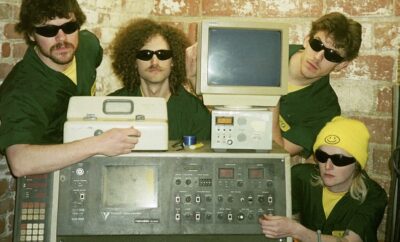 Courtesy of Staple Fiction and Projector Films © 2024
Courtesy of Staple Fiction and Projector Films © 2024
Interviews
Kate Blackmore & Claire Warden – Make it Look Real
By: Malasha Parker
Q) How did you originally get the idea for your feature documentary Make It Look Real about intimacy coordinators on sets?
Kate: I originally got the idea for the documentary from, hearing about Maria Schneider’s experience on Last Tango in Paris, which has now been made into a feature film called Being Maria.
I haven’t seen it, but I can’t wait to watch it. But, yeah, I was completely shocked by hearing about her testimony of that experience, and also [Bernardo] Bertucci’s response and how it was really his intention to humiliate her so that her performance would be real. So, he really kind of undermined her ability as an actor to act that experience out on camera. After that I was hearing more and more actors speaking about their experiences on sex scenes, in talk show situations on YouTube and in social media these experiences were generally like, they sounded like they were kind of exploitative or abusive and kind of terrifying. And I just thought, why isn’t there any support for these people, for these actors, during these scenes? And then I’ve started hearing about the intimacy coordinator role and this was about six years ago.
Q) Claire, how did you get involved in this project?
Kate: So, I did some research, and I found Claire’s name and I contacted her, and I met her in New York, and we started talking about the potential of making a documentary about her work. And she was really keen from the outset. And, yeah, we sort of developed the documentary over a number of years from there.
Claire: Kate reached out to me a little out of the blue. She’d seen, uh, or, or heard my name from, um, her research into intimacy coordination and was coming to New York and asked if I’d be willing to chat and do an interview with her. So, we met in a lovely little studio down on 17th Street. I did an interview about where we were with the work at that point and the developing of it. And it went from there. Kate and Beth [Bruce] decided that they wanted to do more and move forward with the full documentary. And that was that.
Q) What was the process of getting the actors on board with documenting their first sex scenes and their first time working with an intimacy coordinator?
Kate: So, this was a challenge because intimate scenes are usually done on closed set environments. It was really difficult for us to get access to a production that Claire was working on. No one wants a documentary crew filming such sensitive scenes, so we decided that the best and the most ethical way of doing it was to create our own film within the film. So, Tightrope is a film that was kind of created specifically for the purpose of showing Claire’s work in our documentary. It is an actual film, like it has been written as a feature film. We just shot the three intimate scenes out of it for our documentary.
So, the reason it was important to do it this way was so that the actors could consent to being part of the documentary from the outset. So, we cast them with that brief, so they didn’t sign onto it (without knowing about the documentary).
And, yeah, to us that felt like the most ethical way of doing it. And considering the film is all about best practice and ethical practice and respectful practice, it was we had to do it that way, otherwise it would really undermine [laugh] everything the film was about.
We asked Kieran Darcy-Smith, who’s quite a well-known Australian director, to write an outline for a narrative feature and to write the three sex scenes that were gonna be part of the documentary. And he did that. And based on those scenes, we were able to cast the film to act, yeah, to sort of send it out to agents and find some actors who would be perfect for those roles.
And, yeah, we found Sarah [Roberts] and Albert [Mwangi] and Tom [Davis]. And, yeah, we were so lucky to have actors who were so open and generous with kind of sharing their process and their feelings about it. It was a huge ask, but I’m really thrilled with the actors who agreed to be part of the process.
And part of the reason why they wanted to come on board was because they wanted to work with Kieran as well. So, we were really lucky to get Kieran.
Q) What is something about being an intimacy coordinator that you would like to dispel?
Claire: [laughs] Honestly, that it’s an easy job to learn to do. I think there’s a lot of, rightly so, a lot of excitement about this new role. A lot of people respond to the mixture of advocacy and creativity that it has and want to make a positive change, want to make a difference, but it’s an incredibly complex role that combines both the requirement of a full understanding of the art of filmmaking and how various different film sets work. Full career understanding of that with a pretty much full career understanding of really complex communication, mediation, diplomacy, conflict resolution, deep support and understanding of how to mitigate and navigate and work with many people’s different needs, wants, expectations, ways of being and conflicting desires, sometimes along with [laughs] full career level of training of advocacy and into harm disruption and a full understanding of inclusion how to navigate and move forward inclusion in a system that has not been built for it, along with [laughs] a full requirement understanding of choreography and physical storytelling of a very precise nature.
And all that has to happen at the same time. And, also, sorry, there’s also another aspect of requirement of really understanding trauma-informed workspaces, how to create and hold them and how to really deftly attend to each person’s needs in a dynamic way. I think what often happens is that because when you have a good intimacy coordinator you may recognize or notice about fifteen or twenty percent of what they’re doing, really experienced intimacy coordinators. You won’t even [laughs] necessarily cognitive consciously clock what skills they’re employing or what they’re doing at any one time, and the enormous amount of prep that they’ve put into how they are on set on a day. But if they weren’t doing that, the entire room would be different and the entire shooting of the scene would go differently.
I think people look at that and misunderstand how much training and experience is required. So, I want to dispel the myth that you can’t just jump into this with a good heart and a little bit of education about sex or consent that you need to do comprehensive, extensive, long-term training before you can ethically integrally and responsibly call yourself an intimacy coordinator.
Kate: I mean, I think the, the whole film, uh, like the purpose of the whole film is to really demystify the profession of intimacy coordination. I think because, again, intimacy coordinators are usually only required for sex scenes and intimate scenes which happen on closed sets no one really gets to see the work that they do. And I think that’s why there’s such a misunderstanding or misconception of, of the role and people will sort of dismiss it like we’ve seen with Mikey Madison in Anora. So, we really wanted to just capture the entire process in as much detail as possible.
Claire’s role is to support the actors and to have those difficult conversations and to, and to really make sure that they’re feeling comfortable before going onto set. So, there some of the delicate moments. I’m just trying to think of maybe it’s the garments. Yeah, I mean, we just tried to show everything [laughs] that Claire would usually do.
So, I mean, the film is about intimacy, and I hope that it does feel very intimate. That was definitely something that we were hoping to do, but it was also really important that we didn’t, make it sort of sensationalist or gratuitous or titillating.
Everything (sex and intimate scenes) were kind of discussed and agreed to prior in terms of framing of the documentary as well as the drama scenes prior to shooting. So, yeah, it was all just everything that happened as it would on
Q) One of the aspects I liked seeing most is the continued meetings and check-ins with the director of the film to make sure the intimate scenes and shots were always absolutely necessary for the forward movement of the film. How important is that for you to do on each set you work on?
Claire: One of the continued meetings and check-ins with the director of the film to make sure the intimate scenes were shot and always absolutely necessary for the forward movement of the film. How important is that for you to do on each set you work on? It’s vital. It’s a vital, integral part of the role. Every single project I work in the standard first thing I do is meet with the director and talk about what they are wanting and looking for, but then that is just the beginning of our conversation in the beginning of our continued communication.
So, every set I am always ongoing communication, checking in, facilitating communication, conversation between the actors. Like it’s not just, “You have to talk to me,” and then I tell the actors it’s all about, as a team, facilitating ongoing communication and the rest of the creative team as well and the crew. So, constant, constant communication on every single set I work on.
Q) Have you had encounters where the director hasn’t been as compromising? How did you handle those situations?
Claire: Yes, yes, of course. I handle it with being really open and honest about what my job is. My job is there to uphold the consent of the actors. And when that requires that a director doesn’t get the first thing they ask for or something that they want, then what I’m always doing, holding, understanding that frustration, holding space for that desire that can’t be met or that idea that felt really important or that frustration and saying, “Great, let focus our conversation back on what is the moment, what is this story moment or what is the impact that you want this moment to have on the audience.”
What is it that we are trying to create here? And here’s three different ways that we could get that same impact or that storytelling or that moment without this very specific aspect that is against the actor’s consent. So, it’s always bringing it back to a creative approach to finding a solution to collaboration. Me, director, actors, DP, sometimes Director of Photography and bringing us back to we all want to make this the best possible show or movie that we can. And let’s stay focused on finding that.
Q) Why do you believe people are still so hesitant to use intimacy coordinators on set?
Claire: I think there’s a couple of reasons. I think there’s misunderstanding in the industry of what we actually do and how it actually goes. That’s why I’m so pleased that we have this film out so people can actually see the process and understand.
I think the misunderstanding has been created from a couple of areas. I think the intimacy coordinators I spoke about before or people that are not yet fully trained or experienced or ready to take on this role and don’t necessarily understand the most or un understand a diplomatic and nuanced way of doing the role or not quite understood the nuances of consent advocacy. Some actors or directors have worked with them and that has got in the way of their creative process of their work. And it has felt like a burden because it’s misunderstood. [laughs] It has been doing in a way that is not intended. And therefore they believe that is what intimacy coordination is, as opposed to, “Oh, that intimacy coordinator did not work well with the way that this particular team works.”
In the same way as you bring on a director of photography that jives with the way that you work and what your particular needs are for the set you bring in a first AD who understands the needs of this project. You bring in a costume designer whose aesthetic and, experience and skill aligns with yours, right? It’s the same. You have to bring in someone that is qualified and but also understands like what the individual needs of the project are. So, I think people might have had experiences that weren’t helpful or positive for them, and they assume that that is what intimacy coordination always is. And I think change is hard. And I think this change particularly requires that we consider consent and the agency of actors in order to move fully into that shift in the industry, part of us has to admit that that wasn’t always the case.
And that harm has been caused. Now, that’s not a blame or a judgment thing, but, um, it’s, it’s a pain. It’s a hard thing to do. It can be painful to know that you worked in a system that caused harm to know that perhaps you contributed to a system that caused harm to know, to admit that perhaps there were times you didn’t speak up. I have no interest in judgment or blame of that, but in order to fully embrace a change, we have to be honest about what we are moving from. And that can be hard for people. And I think there are people that don’t necessarily understand or prioritize that people that are of a different level of power dynamic or identity than them have different experiences in the workspace. And if someone hasn’t had the experience of not feeling like they had the right to speak up for their own autonomy, they may not understand how important that is. It doesn’t mean that they shouldn’t be fighting for everybody to have it.
Q) How has this documentary educated you on how to be a better director?
Kate: Oh my gosh, it’s so much. [laughs] So, I mean, Claire’s work in general has helped me be a better director and a better person, I would say. So, something that I really learned from Claire was that her work is all about care and kindness and that actually if you foreground those ethics, then you will get a better performance out of your actors or your performers.
And even though I do I work in the documentary space, and it’s so relevant to the kind of filmmaking that I do, I really try to avoid extractive kind of documentary filmmaking, which has sort of given the form a bad name. And I’m very aware of trying to balance the power dynamic between the people in front of the camera and the people behind the camera as much as possible and try to be respectful and collaborate with them, in order to create a more authentic film.
So, I think seeing how Claire works has made me more aware of kind of foregrounding a culture of care on all of my sets or whenever I’m working on location. You don’t need to be a kind of dominating dictatorial director to get the best out of your performers, and as a person I don’t respond to that. So, I just try to do what would feel good for me.
So far, I hope that the documentary feels like it’s sort of imbued with that essence of care in the same way that Claire’s work is because that was intention. And right down to the editing as well, my editor Elliott Magen is such a beautiful, sensitive person and he was really careful to select shots that were showcasing the work in the most respectful way.
I think it’s also made me a better person in the world, just in regard to being able to have the importance of having conversations around your feelings if you’re feeling uncomfortable about something or trying, just asserting boundaries in my personal life as well. I think intimacy coordinators can teach us so much about how to relate to people and how to assert ourselves in situations that make us feel unsafe or uncomfortable be on the film set.
And I’m just in awe basically of the kind of people that they are and how they can support everyone on sets, not just the performers. That’s actually something that I learned as we made the film – the intimacy coordinators aren’t just there to work with the actors on the physicality of a sex scene, which I think is what a lot of people think that they’re there for.
In an ideal situation, they’re working with the writers at script level, and detailing the scenes and making sure that they move the narrative forward as opposed to kind of – the anything sort of gratuitous or kind of slapped on. They work with the cinematographers and the costume department and, as well as the director obviously, and all of the crew.
So, they have interactions with everyone on set and they’re there to really make sure that everyone is comfortable because also you’ve gotta remember that if there is a scene of sexual assault, it’s not just the actors who are experiencing that. It’s the people who are behind the camera, it’s the boom swinger, it’s the sound recordist.
So, these people are sort of watching these scenes play out over and over again, so they need to be protected and supported in the same way that the actors do. And there needs to be some kind of aftercare to leave the work on the set and to try to avoid it from entering it into your personal life, particularly if it’s a sort of scene of sexual assault or violence.
So, intimacy coordinators are essential in that regard. They sort of create the boundary between the personal and the professional and navigate any potential traumas that may occur or that the actors themselves might bring to the set.
They really support people in that. So, intimacy coordinators are great, and I think at the start of making this film I was very aware not to make a documentary that really kind of promoted the work of intimacy coordinators. I mean, I think at that point I wasn’t exactly sure what their role was and how important they were on film sets, but I was just really curious to kind of explore that in the film. And I really wanted to leave it up to the audience to decide whether this is a role that should be mandated. [laughs]
And it’s not mandated at the moment. I mean, HBO was the only production – it’s the only kind of studio to mandate intimacy coordinators. So, yeah, I really hope, and this kind of goes to the last question. I really hope that audiences will see the film and see the value of intimacy coordinators and see the complexity of their work.
Q) Is there any advice you could give to filmmakers on how to handle intimate scenes or to those who may still want to know more about intimacy coordinators?
Claire: I mean, watch this film. They want to know more about intimacy coordinators, watch Make it Look Real because that’ll give you a really powerful into it. Talk to some intimacy coordinators. I mean, call me, talk to me. But like if you are having intimacy, nudity, sex, simulated sex, hyper exposure intimacy in your film, you should be bringing on intimacy coordinator. And so interview them, speak to them. Call an intimacy coordinator that has established themselves doing credible work and say, “Hey, I’ve got some questions and some doubts. Can I talk to you about them?” Right. If you are not sur, and if you doubt or are resistant or reticent, like investigate more, find out, ask, talk to colleagues that have had good experiences with intimacy coordinators and come in with a perspective of, “Let me see if this actually might be good.” Open your minds and be honest about what you want from your project and what you want to understand and learn. If you find a decent one, then they will help you all the way.
Q) What do you hope lingers with audiences who watch Make it Look Real?
Claire: I hope what lingers with them is the effect on Sarah and Tom and Albert from their work and on their feeling about their work and their experience in filming because they have the support of an intimacy coordinator. I hope what lingers is watching Kieran enter into the process and a little trepidatious. And it wasn’t all smooth and easy and yet how proud and pleased he was with what came out of the story of the film at the end. And I hope what lingers with them is that even if we, if we like confronting change and confront and talking and engaging in these important conversations aren’t always comfortable, but they’re really necessary. And once you do it, and once we kind of step towards making change, the next steps become easier. And it is possible to make great films in a way that doesn’t deplete our actors.
Kate: I hope it helps people understand what actors go through, particularly with intimate scenes or, you know, any, any kind of scenes that involve, desire or even kind of sexual violence, anything to do with sex, sex, basically.
I hope that audiences start to question who gets to make these scenes and why they’re watching sex scenes because there are a lot of sex scenes and sexually violent scenes out there that just aren’t necessary.
So, I really hope that it makes people interrogate the reasons behind these scenes and why should they exist and who gets to make them. Thank you so much.
Covered at SXSW 2025





You must be logged in to post a comment Login